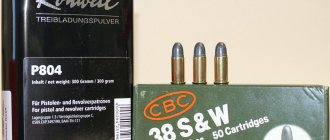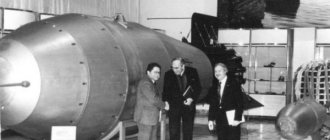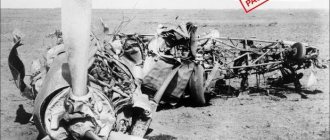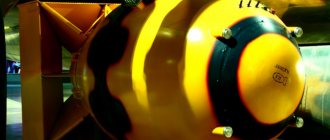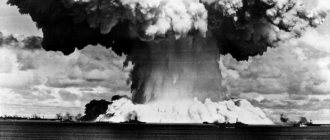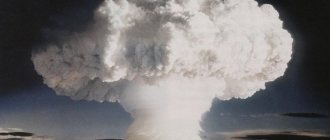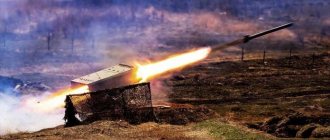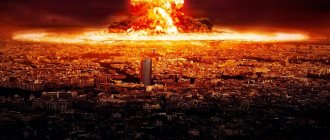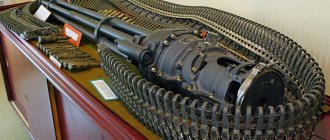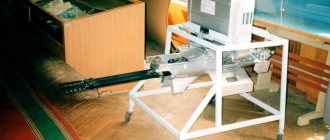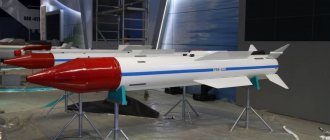Explosion of the “Daddy of all bombs” - the most powerful non-nuclear weapon in the world (Russia) Volumetric explosion ammunition
( BOV
, also known as
thermobaric ammunition
,
vacuum bombs
,
volumetric detonating ammunition
(
ODB
), in English-speaking countries the term
fuel-air bomb
is
- a type of ammunition that uses the spraying of a flammable substance in the form of an aerosol and detonation of the resulting gas clouds.
Large-caliber BOVs are comparable in power to ultra-small tactical nuclear weapons, but they do not have the radiation effect of destruction. The term vacuum bomb
is based on the explosive pressure drop when burning out oxygen in the air, which is 150...170 mm Hg. (enough to damage small vessels and thin cavitary organs).] At the same time, the shock wave of thermobaric ammunition, due to the large volume of the mixture being detonated, actually has a more pronounced negative pressure half-wave than that of conventional explosives.
Technology
The operating principle of the ODB is based on the detonation of a cloud of flammable aerosol. Due to the large size of the cloud (orders of magnitude larger than the size of charges with condensed explosive), the shock wave retains its destructive effect over a long distance. The explosion occurs in two stages
:
- at the command of a fuse, usually a non-contact one, a small charge of a conventional explosive is detonated (its task is to evenly distribute the flammable substance throughout the volume of the cloud);
- with a slight delay, the second charge (or several charges) is detonated, causing the detonation of the aerosol.
The ODB is used as fuel
:
- Ethylene oxide.
- Propylene oxide.
- Methyl and dimethyl acetylene.
- Butyl and propyl nitrite.
Currently, the efforts of engineers working on the creation of thermobaric ammunition are aimed at creating a technology for the formation of a more uniform cloud of air-fuel mixture and a more symmetrical detonation - that is, the conditions under which the maximum effect of the explosion is achieved
.
“Vacuum” myths=””>
Myth-making around ODAB, thanks to some poorly educated journalists from the headquarters, smoothly migrated to the pages of newspapers and magazines, and the bomb itself was called “vacuum”. They say that during an explosion, all the oxygen in the cloud is burned out and a deep vacuum is formed, almost like in space, and this same vacuum begins to spread outward. That is, instead of a front of high pressure, as in a normal explosion, there is a front of low pressure. The term “reverse blast wave” was even coined. What about the press! In the early 1980s, at the military department of my physics department, almost under a non-disclosure agreement, a colonel from the General Staff spoke about new types of weapons used by the United States in Lebanon. Not without a “vacuum” bomb, which supposedly turns it into dust when it hits a building (gas penetrates into the smallest cracks), and the low vacuum carefully places this dust at the epicenter. ABOUT! Wasn’t this clear-headed person planning to demolish the Khrushchev buildings in the same way?!
If these people had studied even a little chemistry at school, they would have guessed that oxygen does not disappear anywhere - it simply transforms during the reaction, for example, into carbon dioxide with the same volume. And if in some fantastic way it simply disappeared (and there is only about 20% of it in the atmosphere), then the lack of volume would be compensated by other gases that expanded when heated. And even if all the gas disappeared from the explosion zone and a vacuum formed, then a pressure drop of one atmosphere could hardly destroy even a cardboard tank - such an assumption would simply make any military man laugh.
And from a school physics course one could learn that any shock wave (compression zone) is necessarily followed by a rarefaction zone - according to the law of conservation of mass. Simply, the explosion of a high explosive (HE) can be considered a point explosion, and a volumetric detonating charge, due to its large volume, forms a longer shock wave. That is why he does not dig craters, but knocks down trees. But there is practically no blasting (crushing) effect at all.
Filmogram of the action of volumetric explosion ammunition
The storyboard clearly shows the activation of the primary detonator to form the cloud and the final explosion of the air-fuel mixture.
Modern volumetric explosion ammunition most often consists of a cylinder, the length of which is 2-3 times greater than the diameter, filled with fuel and equipped with a conventional explosive charge. This charge, the mass of which is 1-2% of the weight of the fuel, is located on the axis of the warhead, and detonating it destroys the body and sprays the fuel, forming an air-fuel mixture. The mixture should be ignited after the cloud reaches the size necessary for optimal combustion, and not immediately at the start of atomization, because initially there is not enough oxygen in the cloud. When the cloud expands to the required extent, it is undermined by four secondary charges ejected from the tail of the bomb. Their response delay is 150 ms or more. The longer the delay, the higher the likelihood that the cloud will blow away; the less, the higher the risk of incomplete explosion of the mixture due to lack of oxygen. In addition to explosive, other methods of initiating a cloud can be used, for example chemical: bromine or chlorine trifluoride is sprayed into the cloud, which self-ignites upon contact with fuel.
From the film footage it is clear that the explosion of the primary charge located on the axis forms a toroidal cloud of fuel, which means that the ODAB provides the maximum effect when it falls vertically on the target - then the shock wave “spreads” along the ground. The greater the deviation from the vertical, the more wave energy is spent on useless “shaking” of the air above the targets.
The release of a powerful volume-detonating munition resembles the landing of the Soyuz spacecraft. Only the ground stage is different.
Giant flash =»»>
But let's return to the post-war years, to experiments with aluminum and magnesium powders. It was discovered that if the explosive charge is not completely buried in the mixture, but left open at the ends, then the cloud is almost guaranteed to be ignited from the very beginning of its dispersion. From the point of view of an explosion, this is a defect; instead of detonation in a cloud, we get just zilch - albeit at a high temperature. A shock wave during such explosive combustion is also formed, but much weaker than during detonation. This process is called “thermobaric”.
The military used a similar effect long before the term itself appeared. During World War II, aerial reconnaissance successfully used the so-called FOTABs - photographic aerial bombs stuffed with a crushed alloy of aluminum and magnesium. The photo mixture is scattered by a detonator, ignites and burns using oxygen from the air. Yes, it doesn’t just burn out - a hundred kilogram FOTAB-100 creates a flash with a luminous intensity of more than 2.2 billion candelas, lasting about 0.15 s! The light is so bright that it blinds not only enemy anti-aircraft gunners for a quarter of an hour - our consultant on super-powerful charges looked at the triggered FOTAB during the day, after which he saw bunnies in his eyes for another three hours. By the way, the photography technology is also simplified - a bomb is dropped, the camera shutter is opened, and after a while the whole world is illuminated by a super-photoflash. The quality of the images, they say, was no worse than in clear sunny weather.
Hit accuracy is compensated by the power of the ammunition
Heavy-duty ODABs resemble huge barrels with appropriate aerodynamics. In addition, their weight and dimensions make them suitable for bombing only from military transport aircraft that do not have bomb sights. Only the GBU-43/B, equipped with lattice rudders and a GPS-based guidance system, can hit the target more or less accurately.
But let's return to the almost useless thermobaric effect. It would have been considered harmful if the issue of protection from saboteurs had not arisen. The idea was presented to surround the protected objects with mines based on thermobaric mixtures, which would burn out all living things, but would not damage the object. In the early 1980s, the entire military leadership of the country saw the effect of thermobaric charges, and almost all branches of the military began to desire to have such weapons. For the infantry, the development of the Bumblebee and Lynx flamethrowers began. The Main Rocket and Artillery Directorate placed an order for the design of thermobaric warheads for multiple launch rocket systems, and the radiation, chemical and biological defense troops (RKhBZ) decided to acquire their own heavy flamethrower system (TOS) "Pinocchio."
This is interesting: Forest Fund
We'll go a different way
The Americans equipped volumetric explosion bombs with ethylene oxide, propylene oxide, methane, propyl nitrate and MAPP (a mixture of methyl acetylene, propadiene and propane). Even then, it was established that when a bomb containing 10 gallons (32-33 l) of ethylene oxide was detonated, a cloud of air-fuel mixture with a radius of 7.5-8.5 m and a height of up to 3 m was formed. After 125 ms, the cloud was detonated by several detonators. The resulting shock wave had an excess pressure of 2.1 MPa along the front. For comparison: to create such pressure at a distance of 8 m from a TNT charge, about 200-250 kg of TNT is required. At a distance of 3-4 radii (22.5-34 m), the pressure in the shock wave quickly decreases and is already about 100 kPa. To destroy an aircraft by a shock wave, a pressure of 70−90 kPa is required. Consequently, such a bomb, when exploded, is capable of completely disabling a parked aircraft or helicopter within a radius of 30–40 m from the explosion site. This was written in specialized literature, which was also read in the USSR, where they also began experiments in this area.
Entertaining physics A shock wave from a traditional explosive, such as TNT, has a steep front, rapid decay and a subsequent flat discharge wave.
Soviet specialists initially tried to depict the German version with coal dust, but gradually switched to metal powders: aluminum, magnesium and their alloys. In experiments with aluminum, it was discovered that it does not give a special high-explosive effect, but it does give a remarkable incendiary effect.
Various oxides (ethylene and propylene oxide) were also used, but they were toxic and quite dangerous during storage due to their volatility: a slight etching of the oxide was enough for any spark to lift the arsenal into the air. As a result, we settled on a compromise option: a mixture of different types of fuel (analogs of light gasoline) and aluminum-magnesium alloy powder in a ratio of 10:1. However, experiments showed that despite the gorgeous external effects, the damaging effect of volumetric detonating charges left much to be desired. The first to fail was the idea of an atmospheric explosion to destroy aircraft - the effect turned out to be insignificant, except that the turbines “failed”, which were immediately restarted again, since they did not even have time to stop. It didn’t work at all against armored vehicles; the engine didn’t even stall there. Experiments have shown that ODAB is specialized ammunition for hitting targets that are not resistant to shock waves, primarily unfortified buildings, and manpower. That's all.
A volumetric detonating explosion has a flatter shock wave front with a more extended high-pressure zone over time.
However, the flywheel of the miracle weapon was spun, and downright legendary feats were attributed to the ODABs. A particularly famous case of such bombs triggering avalanches in Afghanistan. It began to rain awards, including the highest ones. The reports of the operation mentioned the mass of the avalanche (20,000 tons) and wrote that the explosion of a space-detonating charge was equivalent to a nuclear charge. Neither more nor less. Although any mountain rescuer triggers exactly the same avalanches with simple TNT blocks.
They were going to find a very exotic application of the technology in relatively recent times, having developed, as part of conversion programs, a volumetric detonating system based on gasoline for the demolition of Khrushchev buildings. It worked out quickly and cheaply. There was only one “but”: the demolished Khrushchev buildings were not located in an open field, but in populated cities. And with such an explosion, the slabs scattered about a hundred meters.
The explosion of a thermobaric munition has a highly blurred shock wave front, which is not the primary damaging factor.
Operating principle
The incorrect term “vacuum” arose due to the short-term (hundredths of a second) “burnout” of oxygen. In reality, the pressure drop does not exceed 0.5 atmospheres, which is safe for humans. The resulting rarefaction zone is instantly filled with combustion products. And the damaging factor is not “vacuum suction”, but a shock wave.
The very principle of a volumetric explosion consists in the detonation of a flammable substance dispersed in a certain volume of air. The area of contact with air of all aerosol particles is much larger than the substance in its usual form. And the air contains oxygen, an oxidizing agent necessary for an explosion. This “mixing” of a flammable substance with an oxidizer greatly increases the power of the explosion.
Compared to an explosive such as TNT, BOV has 5-8 times more power. However, due to the low density of the sprayed substance, the explosion speed of the CWA is lower. For BOV it is 1500–2000 m/s versus 6950 m/s for TNT. Because of this, its ability to crush obstacles (blasting effect) is lower.
In everyday life, volumetric explosions occur in the form of accidents in enterprises. A high concentration of flammable dust or vapors in the air creates the preconditions for an explosion. Such completely peaceful substances include wood, coal, sugar dust or gasoline vapors.
The implementation of this idea for military purposes is as follows. A projectile or bomb delivers a flammable (explosive) substance to a target and sprays it there. After 100–150 ms, the aerosol cloud detonates
It is important that at this moment the explosive cloud fills the largest space, maintaining the required concentration
The following flammable substances are used: ethylene or propylene oxide, metal powders, MAPP mixture. The latter includes methyl acetylene, allene (propadiene) and propane. Ethylene or propylene oxides are effective but poisonous and difficult to handle. For military purposes, it is easier to use easily evaporating gasoline with the addition of aluminum-magnesium powder.
Advantages of BOV:
- greater explosion power than that of a high explosive;
- the ability of an aerosol cloud to penetrate shelters;
- with a power comparable to tactical nuclear weapons, they do not lead to radioactive contamination.
Disadvantages include:
- instability of the aerosol cloud in adverse weather conditions;
- the presence of a single damaging factor - a shock wave;
- low effectiveness against fortifications;
- explosive mass limitation. For the required ammunition effectiveness, it must be at least 20 kg.
These features will not allow BOV to replace traditional ammunition.
Its use is advisable against enemy personnel in fortifications, natural shelters or urban conditions.
[edit] In the anime
- In the fifty-episode anime Code Geass, at the end of the second season, Britannia (that's two "n") invented a mega-weapon of mass destruction called "Freya". When this prodigy explodes, it divides into zero a piece of spherical space with a huge radius comparable to the size of the city (which, of course, leads to the formation of a vacuum, the process of filling which accounts for most of the frags).
- In the 110-episode “Legend of the Heroes of the Galaxy,” a type of subject with its own oxidizer is known under the name “marshmallow particles.” Actively used against manpower (especially indoors) or large, weakly armored targets. Spraying the subject in the air without an explosion prevents the warring parties from using firearms and beam weapons, so the local infantry fights with battle axes.
The mother and father of all bombs
Until recently, the American Massive Ordnance Air Blast, or more officially GBU-43/B, was considered the most powerful non-nuclear bomb. But MOAB has another, unofficial, decoding - Mother Of All Bombs. The bomb makes a huge impression: its length is 10 m, its diameter is 1 m. Such bulky ammunition is even supposed to be dropped not from a bomber, but from a transport aircraft, for example, from a C-130 or C-17. Of the 9.5 tons of mass of this bomb, 8.5 tons are made up of powerful Australian-made H6 explosives, which contain aluminum powder (1.3 times more powerful than TNT). The radius of guaranteed damage is about 150 m, although partial destruction is observed at a distance of more than 1.5 km from the epicenter. The GBU-43/B cannot be called a precision weapon, but it is guided, as befits a modern weapon, using GPS. By the way, this is the first American bomb to use lattice rudders, widely used in Russian ammunition. MOAB was conceived as a successor to the famous BLU-82 Daisy Cutter and was first tested in March 2003 at a test site in Florida. The military use of such ammunition, according to the Americans themselves, is quite limited - they can only be used to clear large areas of forests. As anti-personnel or anti-tank weapons they are not very effective compared to, say, cluster bombs.
But a couple of years ago, through the mouth of the then Minister of Defense Igor Ivanov, our answer was voiced: a ten-ton “daddy of all bombs,” created using nanotechnology. The technology itself was called a military secret, but the whole world was practicing its wits about this vacuum nanobomb. Like, during an explosion, thousands and thousands of nano-vacuum cleaners are sprayed, which are in the affected area and suck out all the air to a vacuum. But where is the real nanotechnology in this bomb? As we wrote above, the mixture of modern ODAB includes aluminum. And technologies for the production of aluminum powder for military applications make it possible to obtain powder with a particle size of up to 100 nm. There are nanometers, which means there are nanotechnologies.
Inhumane killer
In 1976, the UN adopted a resolution calling explosive weapons “an inhumane means of warfare that causes excessive human suffering.” However, this document is not mandatory and does not directly prohibit the use of thermobaric bombs. This is why from time to time there are reports in the media about “vacuum bombings”. So on August 6, 1982, an Israeli plane attacked Libyan troops with American-made thermobaric ammunition. And most recently, the Telegraph reported that the Syrian military used a high-explosive fuel-air bomb in the city of Raqqa, which killed 14 people. And although this attack was not carried out by chemical weapons, the international community is demanding a ban on the use of thermobaric weapons in cities.
vacuum bomb was tested in Russia
. Channel One reported this. As Alexander Rukshin, Deputy Chief of the General Staff of the Russian Armed Forces, said on September 11, “the test results of the created aircraft munition showed that it is comparable in its effectiveness and capabilities to nuclear weapons.”
The military man especially emphasized that “the effect of this ammunition does not pollute the environment at all compared to nuclear weapons.”
Meanwhile, the place and time of the tests are kept strictly secret.
The operating principle of a vacuum bomb is as follows:
a cloud of sprayed flammable material explodes in the air. The main damage is caused by a supersonic air shock wave and incredibly high temperature. Because of this, the soil after the explosion is more similar to lunar soil, but there is no chemical or radioactive contamination.
The Ministry of Defense emphasizes in every possible way: this military development does not violate a single international treaty. Thus, Russia is not starting a new arms race.
Before this, the most powerful vacuum bomb in the world was in service with the American Air Force. Footage of its tests carried out in 2003 was shown by all television companies in the world, at the same time the superweapon was dubbed the “mother of all bombs.” By analogy, Russian developers nicknamed their new ammunition “the father of all bombs.” This aerial bomb does not yet have an official name, only a secret code. It is known that the explosive contained in it is significantly more powerful than TNT. This was achieved through the use of nanotechnology.
The new vacuum aerial bomb will replace a number of previously created low-power nuclear weapons.
Our response to “partners”
In 2003, the GBU-43/B Massive Ordnance Air Blast Bomb (MOAB) was tested in the United States. The power of its explosion was 11 tons of TNT. At that time, it had no equal in terms of non-nuclear ammunition. Thanks to this, she received the nickname “mother of all bombs” (MOAB - Mother Of All Bombs).
The bomb used BBH-6, a mixture of TNT, hexogen and aluminum powder. It turns out that the ammunition was not a volumetric explosion, but a high-explosive one.
An “asymmetrical” response to the Americans was presented in 2007 in the form of a 7-ton thermobaric bomb.
The TNT equivalent of its power is four times higher than the American figure. Exact information about the new bomb is not available.
The estimated effect ranges from the complete destruction of fortifications within a radius of up to 100 m to the destruction of buildings at a distance of up to 450 m. Journalists rightly dubbed the Russian aerial bomb “the father of all bombs.”
Coal dust
The first test of a vacuum charge was carried out in 1943 by a group of German chemists led by Mario Zippermayr. The principle of operation of the device was suggested by accidents in flour mills and mines, where volumetric explosions often occur. That is why ordinary coal dust was used as an explosive. The fact is that by this time Nazi Germany already had a serious shortage of explosives, primarily TNT. However, this idea was not brought to actual production.
In fact, the term “vacuum bomb” is not technically correct. In reality, this is a classic thermobaric weapon in which fire spreads under high pressure. Like most explosives, it is a fuel-oxidizer premix. The difference is that in the first case, the explosion comes from a point source, and in the second, the flame front covers a significant volume. All this is accompanied by a powerful shock wave. For example, when a massive explosion occurred in an empty storage facility at an oil terminal in Hertfordshire (England) on December 11, 2005, people woke up 150 km from the epicenter to the sound of glass rattling in their windows.
Tactical and technical data of the most powerful aerial bombs
| Air bomb | GBU-43/B | (AVBPM) |
| Affiliation | USA | Russia |
| A year of testing | 2003 | 2007 |
| Length, m | 10 | n.d. |
| Diameter, m | 1 | n.d. |
| Mass, t – total – explosive | 9,5 8,4 | 7 n.d. |
| TNT equivalent, t | 11 | 44 |
| Radius of guaranteed destruction, m | 140 | 400 |
The table shows a fourfold superiority in power with a quarter less total weight.
Obviously, this could be achieved through the use of thermobaric explosives.
This is interesting: Truck crane
Fascinating deadly beauty - thermobaric bomb explosions
Deadly weapons can also be beautiful. Thermobaric bombs or volumetric explosion ammunition are precisely such weapons.
By themselves, these are, of course, ordinary bombs, but their explosion looks truly beautiful.
Volumetric explosion ammunition (BOE), or volumetric detonating ammunition (ODB) - ammunition that uses the spraying of a flammable substance in the form of an aerosol and detonation of the resulting gas cloud. Large-caliber volumetric explosion ammunition is comparable in power to ultra-small tactical nuclear weapons, but they do not have the radiation effect of destruction.
At the same time, the shock wave of volumetric explosion ammunition, due to the large volume of the mixture being detonated, has a more pronounced negative pressure half-wave than that of conventional explosives.
There is also a “newspaper stamp” that gave this type of ammunition the misnomer “vacuum bomb.” Another term “thermobaric ammunition” is also often used, which is often used as a synonym for the term “volumetric explosion ammunition”. This is not entirely true: there are differences between them. Thermobaric charges are structurally composed of a central explosive charge (CBC), made of a conventional explosive with a high detonation speed, around which there is a thermobaric mixture, which is a condensed explosive with a high content of metal fuel.
The explosion of thermobaric ammunition consists of three stages:
1. Detonation of the central reactor plant, producing an initial detonation wave. (Duration - microseconds).
2. The detonation wave from the CRZ initiates the detonation of the thermobaric mixture, which detonates at a lower speed (anaerobic stage, duration - hundreds of microseconds).
3. Expansion and combustion of explosion products due to oxygen in the air behind the shock wave front. In this case, the shock wave promotes mixing and combustion of detonation products due to the surrounding air (aerobic stage, duration - milliseconds or more).
Unlike volumetric detonating charges, thermobaric ones are not limited by an effective mass of 20–30 kg, below which volumetric detonating ammunition ceases to work effectively. This makes it possible to arm small units, down to individual soldiers, with thermobaric weapons.
"The Daddy of All Bombs"
The American television channel CNN spoke about the Russian “father of all bombs, who is capable of evaporating all living things.” The broadcaster claims it may be the most powerful thermobaric bomb, four times more powerful than the largest non-nuclear bomb in US arsenal - the "mother of all bombs". “The daddy of all bombs” is a thermobaric bomb, which means its payload explodes at much higher temperatures. As a result, all living beings located in the detonation zone evaporate,” said retired US Army Colonel Cedric Layton in an interview with the TV channel.
Thermobaric ammunition is not susceptible to atmospheric phenomena (for example, wind), compared to volumetric detonating ammunition, since the explosion does not require time for the formation of a cloud. In addition, the shock wave from the explosion of a thermobaric charge is also capable of flowing into shelters, causing damage. However, the effectiveness of thermobaric ammunition in open areas is relatively low; only in closed and semi-open areas do they show high efficiency due to the intense burning of metal particles on reflected shock waves.
How does this weapon work?
When a volumetric explosion munition is detonated, a shock wave is generated, but it is much weaker than the explosion of a conventional explosive such as TNT. However, the shock wave from a volumetric explosion lasts much longer than from the detonation of conventional ammunition.
If we compare the effect of a conventional charge with a pedestrian being hit by a truck, then the effect of a shock wave during a volumetric explosion is a roller that will not only slowly pass over the victim, but will also stand on it.
However, the most mysterious damaging factor of bulk ammunition is the low-pressure wave that follows the shock front. There are a large number of conflicting opinions about its action. There is evidence that it is the low pressure zone that has the most destructive effect. However, this seems unlikely since the pressure drop is only 0.15 atmospheres.
Jumpers experience a short-term pressure drop of up to 0.5 atmospheres, and this does not lead to lung rupture or eyes falling out of their sockets.
Another feature makes volumetric explosion ammunition more effective and dangerous for the enemy. The blast wave after detonating such ammunition does not go around obstacles and is not reflected from them, but “flows” into every crack and shelter. Therefore, you definitely won’t be able to hide in a trench or dugout if an aircraft vacuum bomb is dropped on you.
The shock wave travels along the surface of the soil, so it is perfect for detonating anti-personnel and anti-tank mines.
Links
- Volumetric explosion ammunition
- Mixtures contained in Volume Explosion Ammunition
| Types of artillery ammunition | |
| Concrete | Armor-piercing high-explosive | Armor-piercing | Armor-piercing incendiary | Incendiary | Tracer | Impact core | Cumulative | Cumulative-fragmentation | Shrapnel | Buckshot | Shrapnel | High explosive | High Explosive | Thermobaric | Chemical | Nuclear | Propaganda | Smoke | Lighting | Sighting and target designating | Special Purpose Ammunition | Non-lethal ammunition |
Thermobaric ammunition
Along with BOV, thermobaric ammunition (TBM) is widely known. With the same effect of oxidation of explosives in the air, the principle of operation of such ammunition differs from BOV.
Due to the detonation of the central explosive charge, the thermobaric mixture detonates. The resulting blast wave ensures rapid mixing with air and combustion of the thermobaric composition. TBB uses a mixture based on nitroesters and aluminum powder.
Advantages of TBB over volumetric detonating:
- no restrictions on the mass of explosives. This made it possible to create fire weapons to arm individual military personnel;
- insensitivity to atmospheric phenomena.
Several types of weapons have been developed under the TBB. The most common ones are:
- rocket infantry flamethrower "Bumblebee";
- shots for RPG-7;
- grenades for an underbarrel grenade launcher.
At the same time, work continues on the creation of high-power thermobaric ammunition.
History of creation and application
Volumetric explosion ammunition (like many other weapons) owes its birth to the evil German weapons genius. During the last world war, the Germans paid attention to the power of explosions that occur in coal mines. They tried to use the same physical principles to produce a new type of ammunition.
Nothing real came of it, and after the defeat of Germany, these developments went to the allies. They were forgotten for many decades. The Americans were the first to remember about volumetric explosions during the Vietnam War.
In Vietnam, the US made extensive use of combat helicopters, with which they supplied their troops and evacuated the wounded. The construction of landing sites in the jungle became a rather serious problem. Clearing an area for just one helicopter to land and take off required the hard work of an entire sapper platoon for 12-24 hours. It was not possible to clear the sites using conventional explosions, because they left behind huge craters. That’s when they remembered about volumetric explosion ammunition.
A combat helicopter could carry several similar ammunition on board, the explosion of each of them creating a platform quite suitable for landing.
The combat use of bulk ammunition also turned out to be very effective; they had a strong psychological effect on the Vietnamese. It was very difficult to hide from such an explosion even in a reliable dugout or bunker. The Americans successfully used volumetric explosion bombs to destroy partisans in tunnels. At the same time, the USSR began developing similar ammunition.
The Americans equipped their first bombs with various types of hydrocarbons: ethylene, acetylene, propane, propylene and others. In the USSR they experimented with a variety of metal powders.
However, the first generation volumetric explosion ammunition was quite demanding in terms of bombing accuracy, was highly dependent on weather conditions, and did not work well at subzero temperatures.
To develop second-generation ammunition, the Americans used a computer on which they simulated a volumetric explosion. At the end of the 70s of the last century, the UN adopted a convention banning these weapons, but this did not stop their development in the USA and the USSR.
Today, third-generation volumetric explosion ammunition has already been developed. Work in this direction is actively carried out in the USA, Germany, Israel, China, Japan and Russia.
Vietnam experience
Thermobaric weapons were first used in Vietnam to clear jungles, primarily for helipads. The effect was stunning. It was enough to drop three or four of these volumetric explosive devices, and the Iroquois helicopter could land in the most unexpected places for the partisans.
Essentially, these were 50-liter high-pressure cylinders with a braking parachute that opened at a height of thirty meters. About five meters from the ground, the squib destroyed the shell, and a gas cloud formed under pressure, which exploded. At the same time, the substances and mixtures used in air-fuel bombs were not anything special. These were ordinary methane, propane, acetylene, ethylene oxide and propylene. It soon became clear experimentally that thermobaric weapons have enormous destructive power in confined spaces, such as tunnels, caves, and bunkers, but are not suitable in windy weather, under water and at high altitudes. There were attempts to use large-caliber thermobaric shells in the Vietnam War, but they were not effective.
Explosive character
The uranium nucleus contains 92 protons. Natural uranium is mainly a mixture of two isotopes: U238 (which has 146 neutrons in its nucleus) and U235 (143 neutrons), with only 0.7% of the latter in natural uranium. The chemical properties of isotopes are absolutely identical, therefore it is impossible to separate them by chemical methods, but the difference in masses (235 and 238 units) allows this to be done by physical methods: a mixture of uranium is converted into gas (uranium hexafluoride), and then pumped through countless porous partitions. Although the isotopes of uranium are indistinguishable either in appearance or chemically, they are separated by a chasm in the properties of their nuclear characters.
The fission process of U238 is a paid process: a neutron arriving from outside must bring with it energy - 1 MeV or more. And U235 is selfless: nothing is required from the incoming neutron for excitation and subsequent decay; its binding energy in the nucleus is quite sufficient.
Chain reaction When hit by neutrons, the uranium-235 nucleus easily splits, producing new neutrons. Under certain conditions, a chain reaction begins.
When a neutron hits a fission-capable nucleus, an unstable compound is formed, but very quickly (after 10−23−10−22 s) such a nucleus falls apart into two fragments that are unequal in mass and “instantly” (within 10−16−10− 14 c) emitting two or three new neutrons, so that over time the number of fissile nuclei can multiply (this reaction is called a chain reaction). This is only possible in U235, because greedy U238 does not want to share from its own neutrons, whose energy is an order of magnitude less than 1 MeV. The kinetic energy of fission product particles is many orders of magnitude higher than the energy released during any chemical reaction in which the composition of the nuclei does not change.
Metallic plutonium exists in six phases, the densities of which range from 14.7 to 19.8 kg/cm3. At temperatures below 119 degrees Celsius, there is a monoclinic alpha phase (19.8 kg/cm3), but such plutonium is very fragile, and in the cubic face-centered delta phase (15.9) it is plastic and well processed (it is this phase that they are trying to preserve using alloying additives). During detonation compression, no phase transitions can occur—plutonium is in a state of quasi-liquid. Phase transitions are dangerous during production: with large parts, even with a slight change in density, a critical state can be reached. Of course, this will happen without an explosion - the workpiece will simply heat up, but a discharge of nickel plating may occur (and plutonium is very toxic).
